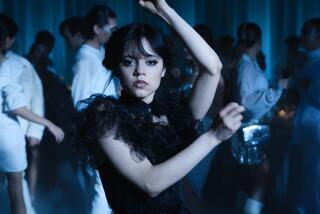‘Toy Story’ and ‘Space Jam’ Are Really Horror Films
- Share via
Being a kid in the summer in the ‘90s means you have to see the movie, buy the toy and eat the fast food, but not necessarily in that order.
Clever marketing executives, it seems, are helping raise our children--their talents affecting everything from nutrition to toilet training and child development.
My son potty-trained at 22 months so he could wear big-boy underwear with Barney on them. His best friend recently refused an impromptu sleepover because he didn’t have his Buzz Lightyear pajamas. His bedtime ritual at home includes the sign off “I come in peace.”
Marketing is this country’s most ingenious creation.
My original thought for my son was that he would play with wooden spoons and strips of leather, but that didn’t happen. Just driving him around town, taking him out to eat, even shampooing his hair--cuddly, posable figurines and toys were always in his line of sight. In fact, the first toy he reached for was a 12-inch Bamm-Bamm doll from the “Flintstones” movie.
This past year he opened every present hoping it was the “Space Jam” Moron Airship (which, by the way, was harder to come by than a Tickle Me Elmo). It turned out to be the most disappointing of his five Christmas mornings so far.
I spent the next day calling every Warner Bros. store in California trying to locate a Moron Airship.
Six or seven long-distance phone calls later I located the toy at a Warner Bros. store in Illinois. They were glad to send it out at twice the price when you add up shipping and credit-card fees. I felt like the moron. How had the marketers gotten to me? Easy. Through my kid.
It’s not the toys themselves--some of them are really cool, like those “Star Wars” miniatures Taco Bell was giving out. As consumers, we created this phenomenon, now we have to help our children navigate it, personalize it and learn from it. Toys and movies help our children assimilate culture and cultural icons, and that’s good. The trouble is that eating, playing and entertainment all blend into one homogenous experience.
My son runs around the house with a plastic doughnut on each ear, singing, “I’m Princess Leia, I’m Princess Leia.” The other day he put a salad bowl over his head and parroted an alien voice chanting: “Mars attacks humans, Mars attacks humans.” And he’s never even seen “Star Wars” or “Mars Attacks!”
Just go to any preschool Halloween parade. There are no mermaids, only “Little Mermaids.” There are no cowboys but lots of Woodys from “Toy Story.” I haven’t seen a princess in years, just “Cinderella.”
I’ve also seen “Hunchback” and “Space Jam” sneakers, “Sesame Street” characters on a piano and “Flintstones” on a yarmulke. My children shared an Alf umbrella and a Tweety Bird raincoat. We own a “Batman Forever” sleeping bag and a Gargoyle water bottle. My son drinks Donald Duck Orange Juice out of a Winnie the Pooh cup. I can step on parts of three different Batmobiles on any given night. And the Barney underwear has been replaced by Space Jam, Gargoyles and the Hunchback.
Recently, a Teenie Beanie promotion was McDonald’s most successful to date. My guess is a Beanie Baby movie and TV series can’t be far behind.
Are movie tie-ins all bad for children? No. They’re fun, even if they don’t stimulate creativity the way a plain-wrap action figure might. For parents, though, surrendering to the onslaught is mildly embarrassing yet unavoidable, unless you raise your kids in a vacuum.
What we need is a happy medium for Happy Meals. One suggestion is to help your children separate their experiences: Make mealtime mealtime, playtime playtime and moviegoing a special outing.
Unless that latest movie knickknack is just too cool to resist.
More to Read
Inside the business of entertainment
The Wide Shot brings you news, analysis and insights on everything from streaming wars to production — and what it all means for the future.
You may occasionally receive promotional content from the Los Angeles Times.










